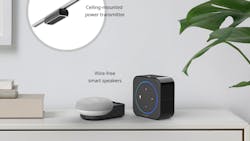Q&A: Wi-Charge founder discusses state, future of long-range wireless charging
How great would it be if you no longer needed to find a cord, wall outlet/plug, or a wired power source to charge your smartphone? The technology to make this happen has been in the hypothetical stage for a while now, but unbeknownst to many, it’s actually available right now. Wireless charging has been widely available in one form or another for most of this decade, largely brought to the commercial front by various technology startups. Long-range wireless charging—which operates much like Wi-Fi Internet—is more recent, and enables devices such as smartphones to be charged from distances up to about 30 feet from the charging source.
Mike Hockett, Evaluation Engineering Editor-in-Chief: Perhaps the oldest and still biggest challenge in wireless charging is that it hasn’t become truly wireless yet. Almost all wireless charging devices/plates need their own charging cable, which in a sense, defeats the purpose, since a smartphone could be charged via that same or similar charging cable. What is being done to combat this challenge industrywide?
Ori Mor, Wi-Charge’s Co-founder and VP of Research & Development: Though charging pads need to be wired, they particularly provide added value in public spaces such as hotels, restaurants, and airports. Charging pads do support a wide range of phones and replace the need to bring a charging cable or to select the right cable for a particular phone. However, I do agree with your premise: wireless charging through wired pads is not really wireless. Imagine, for instance, if to get Wi-Fi on your notebook computer you had to physically touch the wireless router. Would that be considered true wireless?
The solution to this problem is to embed long-range wireless charging in the phone. This would allow charging a phone from across the room, so you could be sitting at home watching TV while your phone is being charged next to you. I believe that in a few years, most high-end smartphones would have long-range wireless charging in them and it would become a ‘must-have’ feature. For this, we believe the Wi-Charge technology that uses infrared light is a particularly good fit because it is the only viable solution to delivering the kind of power that a phone needs while maintaining a power receiver that is not much larger than the cellphone’s camera.
In the near-term, we do offer an interim solution. We’ve shown our ‘AnyCharge’ design, which is a regular charging pad that gets its power from the Wi-Charge long-range wireless power receiver instead of from a wall plug. This allows a restaurant owner to place this charging solution on any table, not just those that are adjacent to power outlets. It saves the time and expense of rewiring the coffee shop and serves as a nice bridge from tomorrow’s charging technology to today’s phones.
MH: Another key challenge is that most of the current generation of wireless chargers need to be closely aligned with the smartphone they are charging in order to successfully transfer power, often requiring precise placement of the phone. Is there a way around this issue?
OM: Alignment is certainly a limitation of magnetic induction, though we’re starting to see ‘multi-coil’ designs that make this a little bit better or clever mechanical designs that help slide the phone into the desired position. But ultimately, magnetic induction has other severe issues—most notably the need to be immediately adjacent to the charger. We see long-range wireless charging is the better solution because it does not require to align the phone with any particular item.
MH: Whereas wired charging enables users to use their phone while it is charging, wireless charging typically requires a phone to stay in place on a charging plate. Is there a way to make wireless charging more mobile so that the phone/device being charged can still be used while charging?
OM: When using the Wi-Charge technology, charging the phone while it is in use could work in some cases. Let me explain. Our energy receiver is like a small solar cell that converts the light from our transmitter into power for the phone. Because we use light, there needs to be line of sight between the transmitter and receiver. Thus, depending on where you embed the receiver into the phone, you could certainly achieve charging during use. You could also embed multiple receivers: For instance, one in the front and one in the back—to cover a wider range of situations.
MH: In a nutshell, what are Wi-Charge’s new wireless power kits, and how do they work?
OM: The new Wireless Power Kits convert—within minutes—an existing Amazon Echo Dot or Google Home Mini speaker into a complete wire-free product. Now that you don’t have to connect these products to an outlet, you have a lot of flexibility on where you use them. For instance, you could hang them on the wall. Or maybe you were previously hesitant to place them in the middle of a coffee table because you were not close to an outlet or you just didn’t like the look of the wire. Now you can.
They work in a similar fashion to the “AnyTable” charger. It is a small cradle that the smart speaker plugs into. The cradle has a rechargeable battery that provides power to the speaker, and that battery is recharged through the Wi-Charge system. One nice thing about this solution is that there is no change in the functionality of the speaker, just additional options on how to use it.
Beyond the value that the kit brings to these particular products, I think it could be an inspiration to other manufacturers or other product types of what can be done with wireless power. For instance, you might consider doing this to an indoor security camera so that you wouldn’t need to replace batteries. Many products could gain more utility and more functionality if they did not need batteries or a power outlet.
MH: Long-range wireless power seems to be a great solution to the challenges above. What have been some of the testing challenges involved with bringing long-range wireless charging to market? And how long do you think it will be until we see this technology become widespread?
OM: The development itself is a long and difficult process because we had to solve a lot of problems. We have a team of top-notch engineers and they were able to make several significant inventions in the process. One thing that was always top-of-mind is safety: we wanted to make sure that the product can be used by consumers with no need for any particular precautions and no training. We were able to prove to U.S. and international regulators that our product is as safe as an optical mouse or a laser printer. We had to go through rigorous testing in accredited labs and prove and document that we meet or exceed all regulations, and we did.
The next step is to find the right partner. Our business is primarily a B2B business: we provide our “wireless power supply” to vendors that wish to build it into their products. We started announcing some of these partnerships and several more are coming. We expect the first consumer products to be available in 2019 and are confident that once people start experiencing this in their homes, the demand would grow very rapidly.
MH: The potential for wireless charging in consumer devices seems endless. How is Wi-Charge’s ‘Powered by Wi-Charge OEM Program’ helping in this area, and what has the OEM feedback been on this initiative?
OM: We get a couple of hundred of partnership requests every month, so we know that OEMs are very excited by the potential that long-range wireless power brings. Not only can it replace batteries and eliminate power cords, but we think it can create a new class of devices. We believe that wireless power and AI are the two big building blocks in the next-generation of smart home devices, just like broadband internet access and speech recognition were critical in the current ones.
The “Powered by Wi-Charge” OEM program offers an accelerated route to market to those visionary OEMs. We provide product, reference designs, expertise and direct support from our engineers. Our goal is to make it as simple as possible for an OEM to build Wi-Charge into their products. Initially, we’re only going to work with a small number of OEMs because we want to ensure top-notch support. Afterwards, we’ll expend this program even more.
MH: Is there anything else you think our audience of electrical test engineers should know about wireless charging technology, or specifically about what Wi-Charge is doing?
OM: Engineers are critical thinkers and as such they should look at the numbers. Anyone can put together a slick brochure, but not many people can actually demonstrate viable solutions. There are three important things in long-range wireless power:
- Power: once you determine how much power you need, check that the technology you are considering can deliver this level of power. The promise of wireless power is so tantalizing that it’s tempting to make fantastic claims that would never be met.
- Distance: how does the power delivered by the wireless technology change over distance? Does it allow you to work in the distances that you care about?
- Safety: Does the technology have safety certifications? If so, for what power and distance combinations? What standards does it meet and what limitations or precautions does it impose on the end users.
If you dig into these questions, I am sure you can find the best technology for your particular need.
About the Author





